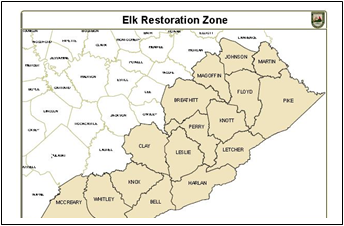Elk basics
Habitat & Movement
Kentucky’s elk habitat is unique from elk herds west of the Mississippi River. Located in 16 counties in Eastern Kentucky, the approximately 4.1 million acres of land of hardwood forests and reclaimed coalmines offer everything an elk herd needs to thrive.
 Image Source: Ky dept. of Fish and Wildlife
Image Source: Ky dept. of Fish and Wildlife
Elk can be found using a variety of habitats. An ideal habitat would consist of areas dominated by herbaceous plants, grasses and a mixture of forest woodlands and openings. This makes Kentucky’s Elk-Zone good habitat for sustaining an elk herd that can sustain hunting pressure. Just like any species of wildlife, elk also need the four essentials of survival -- food, water, shelter and space.
An elk’s diet consists of mostly grasses and shrubs in the spring, summer and fall, with an increase in woody plant materials, such as tree bark and twigs, acorns, hickory and beech during fall and winter months. Locating an area that includes all of these elements will increase your chances of finding elk.
Before & During Rut
Herd structure and socialization among elk changes with the seasons. In relation to hunting, these seasons can be described as “Pre-Rut” and “Rut.” Understanding elk herd structures and how elk interact with each other during these seasons will benefit you as a hunter. The behavior of an elk in Post-Rut and an elk during the winter season will are differ from the behaviors of an elk in than “Pre-Rut” behaviors.
First, what is “Rut”? Rut is the mating or breeding season that occurs in late September or early October for Kentucky. We similarly use the same term when referring to the breeding season of white-tailed deer.
Pre-Rut refers to the time prior to mating or breeding season and after calving season (August- early September). Prior to this time, cows, calves and yearlings will be in loose herds while bulls will spend their days in bachelor groups (bulls only) or on their own. Pre-rut begins the bulls assembly of “harems” or the gathering of cows into groups that he then will defend and breed during the rut. As the season progresses, so does bull vocalization and marking of territorial signs. Rubs and wallows are laced with pheromone scents from glands and urine of the bulls. Typically bulls will have a strong odor from lying down and rolling in their scent filled wallows. These scents will help ward off less-dominate bulls and will also help cows identify the dominant bull of their harem. In many instances, a hunter may smell a bull before they see them!
During the "Rut", the dominant bull will spend much of the day and night guarding its harem of cows and calves from challengers, even if it means missing meals. Bulls will be the most vocal and most territorial during this time, offering the hunter more response to cow and bugle calls. Hunters may also find response from satellite bulls (non-dominate), which can be found on the outskirts of the harems awaiting a chance to sneak in to breed with receptive cows. During bull firearm season and the first segment of bull archery/crossbow seasons are centered around the pre-rut and rut stage. Once either-sex archery/crossbow season comes in, the rut is over.
Post-rut
After breeding season is over, the elk transitions into "Post-Rut" which also changes the strategy of hunting. This time period surprises first-time elk hunters because the elk behavior is different than what is demonstrated in shows and videos. Elk are in Post-Rut from late October through the end of hunting season which is mid-January. During this time, bulls are starting to leave cows and join up with other bulls. The elk are quieter and are usually in heavy cover. They tend to be in herds for survival for the winter. The animals will lay down on north facing slopes during warm days or south facing slopes on cold days. Bachelor bulls can be found in a herd foraging for food to add extra body weight. Hunters should find a good spot to glass (search and scan) for elk. Elk still feed in open areas; it just depends on pressure. They are going to feed in the easiest and safest location they can find. Bulls feed to add extra weight in order to make up for weight loss during the rut. This is a way for bull elk to conserve energy by not traveling long distances to eat. After the rut, bugling is not as effective as it is during rut. When using calls during post rut, use sounds that match how the elk communicate. This can be done by making soft chirps at different tones to make it sound like there are multiple elk.
During the day, the elk will be bed in a safe place which is usually in dense woods. An ideal hunting strategy would be to blow the cow call periodically while traveling in thick brush. The call will bring them comfort so you are able to narrow down the distance between you and the elk. Having patience and knowing their behavior after rut will increase your success during hunting this time of year.